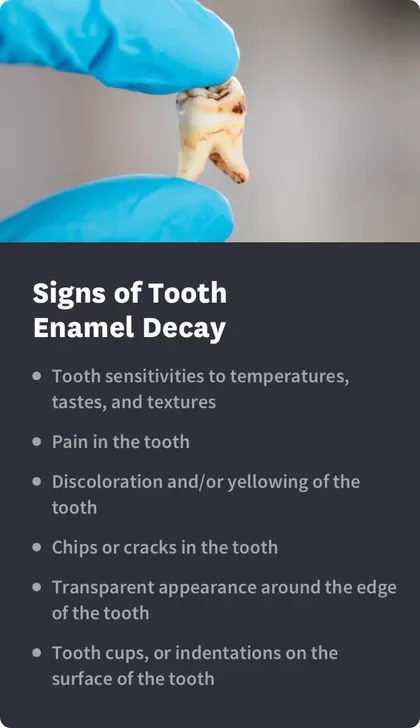Signs of Tooth Enamel Decay & How to Repair

Table of Contents
- Tooth Decay Signs
- Treatment for Decay
- Dangers of Non-Treatment
- Repairing Decay
- References
Tooth enamel decay impacts people of all ages. In fact, untreated tooth decay affects close to half of the population across the globe.
Enamel is the hard, outer layer of your teeth that is designed to protect teeth from the bacteria in your mouth. The calcium in your saliva helps to repair enamel daily. But acids in the foods you eat can overwhelm these minerals and lead to decay.
This decay can be caught early, as it progresses slowly over time. Good oral hygiene can slow the damage.
Recognizing Tooth Decay

Tooth decay builds up as acids in foods and drinks that are sugary or starchy eat away at the enamel, and the minerals in your saliva can’t break them down fast enough. Over time, tooth decay occurs.
Early tooth enamel decay can cause a white spot to appear on your tooth. As decay progresses and more enamel is destroyed, a cavity can form.
Catching tooth decay early is key to protecting and taking good care of your teeth. Signs of tooth enamel decay to watch out for include:
Tooth sensitivities to temperatures, tastes, and textures.
Pain in the tooth.
Discoloration and/or yellowing of the tooth.
Chips or cracks in the tooth.
Transparent appearance around the edge of the tooth.
Tooth cups, or indentations on the surface of the tooth.
Tooth enamel decay can cause discomfort and discoloration of your teeth and can lead to bigger issues if left untreated.
Early Treatment for Tooth Enamel Decay
Your tooth enamel can repair itself. This means you can potentially stop or even reverse tooth decay if you catch it early enough.
As soon as you notice any of the signs of tooth enamel decay, there are some steps you can take to protect your teeth.
Limit sugary and starchy foods and drinks, such as soda and fruit juices.
Try not to snack as often between meals. This allows the minerals in your saliva to repair enamel.
Brush your teeth with a fluoride toothpaste at least two times a day. Acids won’t be able to sit on and eat away at your teeth.
Stop smoking or using tobacco products.
Floss regularly and use a fluoride mouthwash.
Keep up with regular dental cleanings and appointments. A professional can recognize early signs of decay and begin treatment right away.
To further protect teeth from enamel decay, especially in young children, dentists can paint on clear plastic coatings called sealants. These will cover some of the irregular surfaces of the back teeth that can be hard to brush. Sealants will prevent food from getting stuck in these areas.
Dangers of Untreated Decay
Left untreated, tooth enamel decay can be painful. It can lead to permanent damage in the form of a cavity, infection, and possible tooth loss.
Tooth decay, also called dental caries, is the most common chronic disease in adults and children alike. It impacts people of all ages.
Advanced tooth decay can cause significant pain, making it hard to work and function in daily life. It can also lead to anxiety and embarrassment over the way your teeth look.
Thankfully, tooth decay is treatable. The earlier treatment begins, the better.
Repairing Tooth Enamel Decay
There are several ways that your dentist can treat and repair tooth enamel decay. The chosen approach will largely depend on how far along the decay is. The worse the decay, the more significant the treatments will need to be to fix the problems.
Fluoride can be found in tap water, mouth rinses, and toothpastes. Water fluoridation can lower teeth decay in children by as much as 18 to 40 percent, the Centers for Disease Control and Prevention (CDC) publishes.
Professional fluoride treatments can help to restore tooth enamel. In the early stages of a cavity, these treatments can even help to reverse the damage.
Fluoride can be brushed onto your teeth as a varnish, gel, foam, or liquid. These professional treatments contain more fluoride than you can get from other sources.
This procedure places resin, which is a tooth-colored composite, onto your teeth to cover up any discoloration, chips, or cracks. It can further protect your teeth.
Bonding is a cosmetic procedure that is typically cheaper than veneers or crowns.
Once tooth decay leads to a cavity, it will need to be filled with amalgam, resin, or other specialized materials. The filling helps to even out the surface of your tooth, preventing further damage.
Fillings are the most common treatment for cavities. They are also called restorations.
If your tooth is significantly decayed or weak, the entire crown will often need to be replaced with a resin, metal, porcelain, or composite material that is custom fit to your tooth. Your dentist will first remove all of the decayed part of your tooth and then fit a synthetic crown over the rest.
Advanced tooth decay can impact the pulp, which is the inner layer of your tooth. A root canal removes the diseased portion of your tooth in an attempt to repair and restore it without removing the full tooth.
If the tooth enamel is significantly decayed and can’t be salvaged, the tooth will need to be extracted completely.
The best treatment for tooth decay is preventative. Maintain good oral hygiene to keep enamel strong and healthy.
